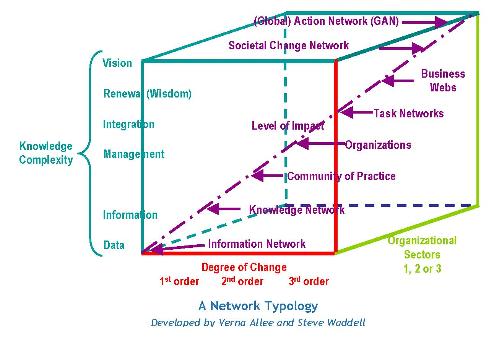Networks & change
The word “network” is often used in different and confusing ways, since it simply refers to interconnections. Networking Action’s focus is inter-organizational. The concept of network is used in a very specific way that can be most easily distinguished from other organizing concepts through the table* below.
| Organization | Partnership | Network | System | |
|---|---|---|---|---|
| Legally Distinct Entity | One | Small to Modest | Very Large | All Stakeholders |
| Organizing Structure | Hierarchial | Hub and Spoke | Multi-Hub | Diffuse |
| Organizing Logic | Administering/Managing | Coordination | Coherence | Diverse Self-Direction |
| Operating Focus | Organization | Task | System | Definitional |
| Participation | Closed | Highly Controlled | Loosely Controlled | External |
* Source: Adapted from Waddell, Steve and Sanjeev Khagram. “Multi-stakeholder global networks: emerging systems for the global common good.” Pp. 261-287 in Partnerships, Governance And Sustainable Development: Reflections on Theory and Practice, edited by P. Glasbergen, F. Biermann, and A. P. J. Mol. Cheltenham Glos, UK: Edward Elgar Publishing.
NetworkingAction aims to enhance effectiveness of networks and their development. This requires clear frameworks for thinking about networks. Often the words “synergies”, increased “efficiencies” and enhanced “effectiveness” are associated with the rationale for creating a network. In order to assess a network’s success and guide its development, it is best to have a clearer understanding than these broad terms provide, of the goal of doing work by network. The Table below aims to describe these.
| Goal | Rationale |
|---|---|
| Greater efficiency | Strengthening ties supports reduced duplication of efforts. |
| New benefits of scale | Strengthening ties supports ability to aggregate linearly for greater impact/leverage. |
| Innovation | Creating networks with diverse voices, perspectives and resources supports emergence of new ways to approach issues and integrate resources |
| Enhanced Coherence | Strengthening ties supports actions on behalf of “the system”, the potential for asserting goals of the broader system, and reducing “friction” |
| Improved coordination | Creating networks broadens the options for action and enhances exchange of information and knowledge. |
Types of networks
Most often network categories are simply descriptive, such as degrees of centralization. However, categories should connect to the purpose and strategy of a network. The table below describes networks by their core strategy, that should determine structure.
| Strategy | The Driving Need |
|---|---|
| System Organizing | There is an emerging system of diverse stakeholders working on and affected by a specific issue or opportunity. A key role of the network is to bring them together and generate coherence in strategies. |
| Learning, Research, and Devel. | To realize the network goals, new knowledge and capacity must be developed. A key role of the network is to develop and disseminate new knowledge and tools with research, piloting new approaches, and training. |
| Shared Visioning | There are diverse stakeholders with diverse perspectives on an issue and what should be done about it. A key role of the network is to create events and interactions that generate shared understanding and alignment of strategies. |
| Measuring | There is need to quantify and measure a phenomenon, in order to advance a network’s vision. A key role of the network is to develop indices, assessments and/or certification processes. |
| Advocacy | There is need to mobilize voice and increase pressure upon specific stakeholders who are blocking (actively or inactively) change. A key role of the network is to develop this pressure. |
| Financing | Sometimes people see that availability of funding is holding back a critical goal. Stakeholders combine forces to aggregate their impact and create a more efficient funding vehicle than any one on its own. |
Table drawn from: 2009.Strategies and Structures of Global Networks: Learning for Global Knowledge Partnership 3.0. A report to the Board of the Global Knowledge Partnership. June. 3. Paris, France.
Most helpful are frameworks that are not only descriptive, but also “explanatory”. That is to say, they explain why a network is centralized or highly decentralized in terms of its strategy and work. The diagram below aims to bring out some of these underlying factors.

This diagram suggests that there are three key activities that can influence a network’s structure, strategy and operations; a fourth activity is also relevant although a fourth dimension cannot be drawn:
- Knowledge Complexity: Does a network aim to simply generate data, or share information, or generate new visions that embed the knowledge?
- Degree of Change: Does a network aim to simply replicate a proven approach (1st Order Change – Scaling Up), implement a new approach (2nd Order Change -Reform), or develop a new approach (3rd Order Change – ;Transformation)?
- Organizational Sectors: Does a network aim to engage organizations from 1, 2 or three of the following sectors: business, government, civil society?
- Geographic/Cultural Complexity: Does a network aim to be local, national, regional, or global?
The purple diagonal aims to suggest that combining these activities in different ways can produce a range of networks. A “higher” network must be proficient at all the “lower” network activities. For example, a Knowledge Network must also be an effective Information Network. The most complex of networks — one that is global, aiming for transformation by engaging all three sectors and developing new visions — is called a “Global Action Network” (GAN). See the Global Action Networks area for more information.


